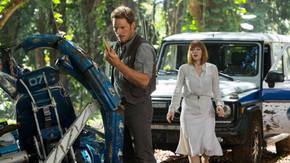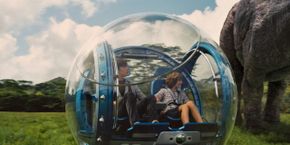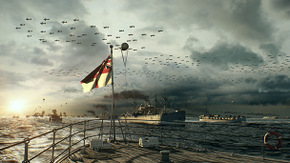 JURASSIC WORLD
JURASSIC WORLD
Hopefully it won't happen for many, many years. But when Steven Spielberg eventually passes away, will any of us be allowed to notice?
Four years ago, in the beyond-irritating Super 8, J.J. Abrams demonstrated that he could ape Spielberg's signature visual style and schmaltzy excesses, and might have gotten away with the directorial "homage" if his script weren't so feeble. And now there's Jurassic World, which proves that even a director with only one previous feature on his résumé - and an eccentric little indie, at that - can assume the master's mantle and deliver an almost frighteningly accurate approximation of his techniques. What's missing in both movies, and what isn't in most Spielberg, is any sense of soul, but then again, there's not yet evidence that clones possess souls.
It makes sense that studios, and maybe even Spielberg himself, would want to continue creating directors in his image. If it worked for God, why not the god of Hollywood blockbusters? (Spielberg was a producer on Super 8 and executive producer on Jurassic World.) Yet as a fan, for the most part, of 2012's Safety Not Guaranteed, I was more than a bit disheartened to find that film's director, Colin Trevorrow, so willing to abandon his nascent filmmaking personality for a full-on Steven Spielberg impersonation. Jurassic World does its job, and Trevorrow does his job. This sequel, though, has been so fanatically engineered to replicate Spielberg-ian wonder and scares and corn that, as a stand-alone experience, it feels eerily lifeless, like a perfectly rendered waxwork at Madame Tussauds.
Did my packed Friday-morning audience appear to care? Not really; there was hearty, sustained applause at the end, and the dopey gags and tongue-in-cheek references to the original Jurassic Park - especially the brief reappearance of Mr. DNA - scored their laughs. (So did the unexpected arrival of Jimmy Fallon, amusingly cast as this film's voice of Richard Kiley. They spared no expense.) But while it's possible that my fellow patrons, a majority of them kids, were simply too amazed and/or terrified to vocalize, I heard a grand total of zero shrieks during the movie's many dinosaur attacks and zero awed mumblings at all the CGI majesty on-screen. For a large-scale summertime popcorn entertainment designed for chills and thrills, the crowd was almost shockingly sedate despite that end-credits applause, and I think that's telling. As presented, Jurassic World isn't a movie to be swept into. It's a movie to be appreciated - a reverent salute to the enduring legacy of Steven Spielberg. (Our heroes' climactic walk into the sunset is so nobly staged that it may as well be wrapping up Saving Private Ryan.)
 Thankfully, there are also dinosaurs, so this thing can't help but be some fun. The satisfyingly simple storyline credited to four (!) screenwriters finds a genetically modified monstrosity called Indominus rex escaping his confines and wreaking havoc on the outskirts of Jurassic World, the dino-centric theme park that's making a bundle despite, you know, all those unfortunate deaths that transpired at the last one. Our human representatives are a succession of Spielberg types: Chris Pratt is the smirking yet stalwart hero; Bryce Dallas Howard is the tightly wound female with whom Pratt can spar; Ty Simpkins is the wide-eyed little science nerd; Nick Robinson is his teasing, protective big brother; Vincent D'Onfrio is the figure of military hubris; Irrfan Khan is the figure of monetary hubris; Jake Johnson, a Safety Not Guaranteed castmate, is the resident wise-ass. (We're also treated to brief turns by the magnificent Judy Greer and The Office's unsung MVP Andy Buckley, and Jurassic Park's B.D. Wong returns and is nicely set up for more demanding duties in the inevitable Jurassic World 2.)
Thankfully, there are also dinosaurs, so this thing can't help but be some fun. The satisfyingly simple storyline credited to four (!) screenwriters finds a genetically modified monstrosity called Indominus rex escaping his confines and wreaking havoc on the outskirts of Jurassic World, the dino-centric theme park that's making a bundle despite, you know, all those unfortunate deaths that transpired at the last one. Our human representatives are a succession of Spielberg types: Chris Pratt is the smirking yet stalwart hero; Bryce Dallas Howard is the tightly wound female with whom Pratt can spar; Ty Simpkins is the wide-eyed little science nerd; Nick Robinson is his teasing, protective big brother; Vincent D'Onfrio is the figure of military hubris; Irrfan Khan is the figure of monetary hubris; Jake Johnson, a Safety Not Guaranteed castmate, is the resident wise-ass. (We're also treated to brief turns by the magnificent Judy Greer and The Office's unsung MVP Andy Buckley, and Jurassic Park's B.D. Wong returns and is nicely set up for more demanding duties in the inevitable Jurassic World 2.)
They're all welcome - well, except for Howard, whose insultingly written ninny in spike heels seems designed for viewers who, after The Help, were dying to see the poor actress eat even more shit. (A girl of about 12 sat in front of me at my screening, and the only time I heard her was when our leads kissed and she blurted, "Oh, gross!" Given Howard's wholly unappealing character, the outburst, I thought, made sense.) But stuck in such formulaic and unsurprising roles, none of them is interesting; even the usually reliable Pratt is only compelling because you can't tell if he's trying for an Indiana Jones parody or the genuine article. The one true shock of Jurassic World is that it's the dinosaurs, specifically the velociraptors, who've been given the personality. Our first image of Pratt finds him training these creatures, with unexpected success, to follow his commands, and the scene consequently establishes the one true element of suspense the picture has to offer: Will these "housebroken" raptors eventually turn their vicious attentions on other dinosaurs or on humans? Their torn looks when faced with this conundrum are worthy of Sophie's Choice.
 During rare set pieces, Jurassic World is exactly the sensational time you want it to be. An airborne siege by dozens of pteranodons tearing through Jurassic World's Main Street is admirably nasty and funny - a less gruesome variant on the peerless beachfront attack in 2010's Piranha 3D - and there's threatening playfulness in the sequence that finds Simpkins and Robinson swatted around a field of dinosaurs while trapped in an oversize hamster ball. Plus, the movie is filled with lovely fringe touches, such as the velociraptor's confusion when confronting a dinosaur hologram, and the wide shot of a half-dozen brachiosauruses killed by that Indominus rex. (To be honest, though, there was such breathless lead-up to this colossus' first appearance that when it was unveiled, it didn't seem as big as advertised. And that's what she said.) But it's tough, if not impossible, to ever feel fully connected to a film's goings-on when it feels like it's just checking off boxes - and in this case, they're boxes that Spielberg fans have been familiar with for ages.
During rare set pieces, Jurassic World is exactly the sensational time you want it to be. An airborne siege by dozens of pteranodons tearing through Jurassic World's Main Street is admirably nasty and funny - a less gruesome variant on the peerless beachfront attack in 2010's Piranha 3D - and there's threatening playfulness in the sequence that finds Simpkins and Robinson swatted around a field of dinosaurs while trapped in an oversize hamster ball. Plus, the movie is filled with lovely fringe touches, such as the velociraptor's confusion when confronting a dinosaur hologram, and the wide shot of a half-dozen brachiosauruses killed by that Indominus rex. (To be honest, though, there was such breathless lead-up to this colossus' first appearance that when it was unveiled, it didn't seem as big as advertised. And that's what she said.) But it's tough, if not impossible, to ever feel fully connected to a film's goings-on when it feels like it's just checking off boxes - and in this case, they're boxes that Spielberg fans have been familiar with for ages.
Again, the first human fatality has to be a victim of color, the fat people have to be cowardly, and every female with more than two lines - all four of them here - has to, at some point, break down in sobs. But the Spielberg echoes extend far beyond Spielberg's, and now Trevorrow's, casually insensitive stereotyping. The weeping of children is used for gross manipulation (Simpkins' come out of freaking nowhere), and the requisite absent parents and tearful reunions are duly accounted for. Theoretically harrowing chase scenes are filled with jokey banter, and the generally intense music cues turn sprightly as soon as an immediate danger has passed. (As Michael Giacchino composed the scores for both this film and Super 8, it's good to know we also have a replacement John Williams on tap.) Heroes stare heavenward in awe. Villains are lit like Satan's minions. Even the effects feel like old-hat Spielberg, as the CGI dinosaurs - with the possible exception of the detail in their eyes - don't look noticeably different than they did 22 long years ago. That's surely a testament to how truly state-of-the-art Jurassic Park was, but it's also a reminder that, more than two decades after that film's debut, the Spielberg-iness of Jurassic World is just a pale imitation.
 D-DAY: NORMANDY 1944
D-DAY: NORMANDY 1944
The Putnam Museum's new D-Day: Normandy 1944 feels to me like the venue's first edu-tainment geared expressly for adults, and speaking as an adult, I couldn't be more thrilled. Its writer/director, Pascal Vuong, might respectfully disagree with my assessment, considering that this 45-minute account of World War II's defining battle, and what transpired in the months that followed, has been made with exquisite thought for potential younger patrons. (The film's examinations of useful wartime vehicles, and its transitions introducing the "What?", "Where?", and "Why?" of the war's particulars, are even visualized in pop-up-book form.) There are no horrific images - or, thank goodness, re-creations - of D-Day carnage or WWII genocide, narrator Tom Brokaw speaks with firm but friendly clarity, and Vuong does an exemplary job of making the central battle's logistics understandable to viewers with even a rudimentary understanding of world geography.
But good lord there's a lot of information to absorb, and while some of it will no doubt baffle grade-schoolers, adults and middle- and high-schoolers with an appreciation for history might find D-Day: Normandy 1944 overwhelming in the most satisfying way. Even given the movie's length, or lack thereof, there are detailed and perfectly lucid explanations for why Normandy, on June 6, was decided on as the point and date of attack, and the exposition is overflowing with fascinating, thinking-outside-the-box footnotes that, in reflection, make staggering sense. (We learn, for instance, that the Allied forces used old postcards from the region to familiarize themselves with the terrain, and that tidal and lunar cycles were largely responsible for the choosing of that Tuesday-morning beachfront siege.) There are well-delineated visual renderings, with rich commentary, of the troops moving from the beach across Europe, as well as all manner of particulars involving the French Resistance, misinformation supplied to the Germans, and even the spirits of the troops and European citizens, read (and, in the one touch I found unnecessary, re-enacted) through personal correspondence. All this plus some of the most magnificent CGI I've ever seen in an edu-doc, thrilling sound effects, evocatively beautiful sand animation, and a score composed by Franck Marchal - and performed by the London Symphony Orchestra - that makes you want to stand and salute. Taken overall, it might be the single strongest documentary I've yet had the privilege to see at the Putnam. Bring the kids if you want.








